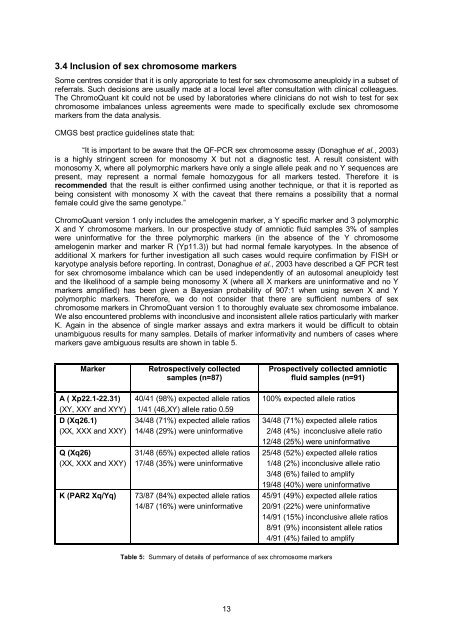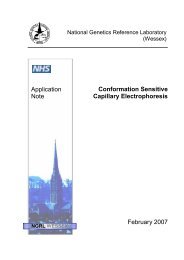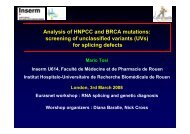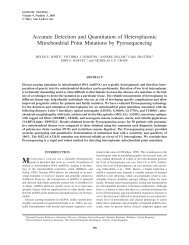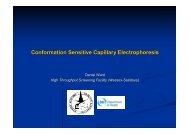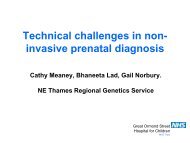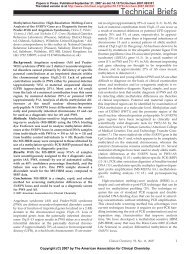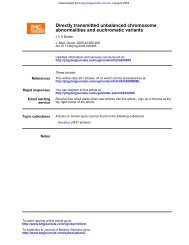(Wessex) Technology Assessment ChromoQuant⢠(version 1)
(Wessex) Technology Assessment ChromoQuant⢠(version 1)
(Wessex) Technology Assessment ChromoQuant⢠(version 1)
Create successful ePaper yourself
Turn your PDF publications into a flip-book with our unique Google optimized e-Paper software.
3.4 Inclusion of sex chromosome markersSome centres consider that it is only appropriate to test for sex chromosome aneuploidy in a subset ofreferrals. Such decisions are usually made at a local level after consultation with clinical colleagues.The ChromoQuant kit could not be used by laboratories where clinicians do not wish to test for sexchromosome imbalances unless agreements were made to specifically exclude sex chromosomemarkers from the data analysis.CMGS best practice guidelines state that:“It is important to be aware that the QFPCR sex chromosome assay (Donaghue et al., 2003)is a highly stringent screen for monosomy X but not a diagnostic test. A result consistent withmonosomy X, where all polymorphic markers have only a single allele peak and no Y sequences arepresent, may represent a normal female homozygous for all markers tested. Therefore it isrecommended that the result is either confirmed using another technique, or that it is reported asbeing consistent with monosomy X with the caveat that there remains a possibility that a normalfemale could give the same genotype.”ChromoQuant <strong>version</strong> 1 only includes the amelogenin marker, a Y specific marker and 3 polymorphicX and Y chromosome markers. In our prospective study of amniotic fluid samples 3% of sampleswere uninformative for the three polymorphic markers (in the absence of the Y chromosomeamelogenin marker and marker R (Yp11.3)) but had normal female karyotypes. In the absence ofadditional X markers for further investigation all such cases would require confirmation by FISH orkaryotype analysis before reporting. In contrast, Donaghue et al., 2003 have described a QF PCR testfor sex chromosome imbalance which can be used independently of an autosomal aneuploidy testand the likelihood of a sample being monosomy X (where all X markers are uninformative and no Ymarkers amplified) has been given a Bayesian probability of 907:1 when using seven X and Ypolymorphic markers. Therefore, we do not consider that there are sufficient numbers of sexchromosome markers in ChromoQuant <strong>version</strong> 1 to thoroughly evaluate sex chromosome imbalance.We also encountered problems with inconclusive and inconsistent allele ratios particularly with markerK. Again in the absence of single marker assays and extra markers it would be difficult to obtainunambiguous results for many samples. Details of marker informativity and numbers of cases wheremarkers gave ambiguous results are shown in table 5.MarkerRetrospectively collectedsamples (n=87)Prospectively collected amnioticfluid samples (n=91)A ( Xp22.122.31)(XY, XXY and XYY)D (Xq26.1)(XX, XXX and XXY)Q (Xq26)(XX, XXX and XXY)K (PAR2 Xq/Yq)40/41 (98%) expected allele ratios1/41 (46,XY) allele ratio 0.5934/48 (71%) expected allele ratios14/48 (29%) were uninformative31/48 (65%) expected allele ratios17/48 (35%) were uninformative73/87 (84%) expected allele ratios14/87 (16%) were uninformative100% expected allele ratios34/48 (71%) expected allele ratios2/48 (4%) inconclusive allele ratio12/48 (25%) were uninformative25/48 (52%) expected allele ratios1/48 (2%) inconclusive allele ratio3/48 (6%) failed to amplify19/48 (40%) were uninformative45/91 (49%) expected allele ratios20/91 (22%) were uninformative14/91 (15%) inconclusive allele ratios8/91 (9%) inconsistent allele ratios4/91 (4%) failed to amplifyTable 5: Summary of details of performance of sex chromosome markers13


